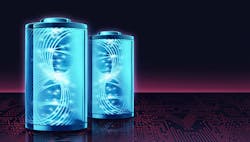Energy storage is the key to a green energy economy. Intermittently available energy supplies have to be converted into continuously available ones that can be stored and transported. The global energy storage market—if we include electric vehicle batteries—could see a five-fold increase in the next eight years, from 800 gigawatt-hours today to as much as 4,000 gigawatt-hours by 2030, according to the U.S. National Renewable Energy Laboratory.
For most of us, electricity storage means batteries, but in a decade or two, this might change. Why? Because one kilogram of a lithium battery can store only 0.15-0.25 kWh of electricity, while one kilogram of hydrogen contains 39.6 kWh, and battery technology won’t be catching up any time soon.
In addition, while batteries can serve stationary and relatively small users (such as storing solar energy for private homes or in cars), they aren't suited for transporting large quantities of electrical energy. In the case of larger green energy sources like solar farms, transportation as hydrogen is better because the existing grids in the area are likely to be undersized, the losses through the grid are large and—even if the grid is updated—its installation and maintenance cost are higher.
By contrast, hydrogen can be stored and transported in any quantity to any user, in a similar manner to natural gas today. One possibility for rapidly expanding the hydrogen delivery infrastructure is to adapt part of the natural gas distribution system to carry a blend of natural gas and hydrogen (up to about 15% hydrogen), which requires only modest modifications. Converting to deliver pure hydrogen may require more substantial modifications. Current research and analyses are examining both approaches (1).
In addition, hydrogen can also be stored in natural or artificial salt caverns (2). The Teeside salt cavern in the U.K. stores 25 GWh of hydrogen at 45 bar pressure in three separate cavities, while the Clemens Dome salt cavern in Texas has a capacity of 92 GWh and pressure in the range of 70–135 bar. Two larger salt caverns (Moss Bluff and Spindletop), also in Texas, have capacities of 120 GWh (3). As for distribution, in addition to trucks, ships and trains, there are currently only about 3,000 km of commercial hydrogen pipelines worldwide (of which 1,300 km are in the U.S.), but eventually the millions of miles of natural gas pipelines can also be adapted for that purpose (4).
EV status report
The public perception that switching to battery-electric vehicles (BEV) will lower carbon emissions is mistaken because batteries are most often recharged with "grey” electricity, generated in carbon-emitting power plants or by other carbon-emitting processes. Today, only about 4% of BEVs use green electricity. A similarly low percentage of fuel-cell-operated electric vehicles (FCEV) use green hydrogen, though these percentages are slowly rising as more solar-roof-generated electricity is being used to recharge the families' electric cars. (In California, for example, there are 1.3 million solar homes and storage is compulsory.)
Ten years ago, only about 25,000 BEVs were on the roads. Today, they number 5.6 million, and by 2030, their number is projected to rise to about 200 million (10% of the total). Today, the global number of FCEVs (including buses and trucks) is roughly 100,000—small, but still larger than the number of BEVs a decade ago. The rate of increase of BEVs is limited by infrastructure availability. For example, there are now 125,000 regular gas stations in the U.S., while the global number of BEV charging stations in 2019 was only 25,000 and the number of hydrogen-fueling stations was about 500.
BEVs are superior to FCEVs in terms of costs and infrastructure availability. In Europe, prior to the Ukraine events, drivers paid around nine to 12 euros to drive 100 kilometers in an FCEV, while a BEV cost only two to seven euros per 100 kilometers (depending on electricity prices and subsidies in individual countries). The advantages of FCEVs include a free and unlimited fuel source, they emit only water, and driving range is higher, while their weight, refueling time and noise levels are all lower than that of BEVs.
Battery limitations
Today, lithium-ion batteries are the dominant design. They contain lithium (Li), cobalt (Co), and nickel (Ni) in the cathode, graphite in the anode, as well as aluminum and copper in other cell and pack components. The electric storage capacity of a BEV averages about 60 kWh for regular and 12 kWh for plug-in hybrid EVs (PHEVs), respectively. Between 2020 and 2050, it's estimated the demand for lithium and cobalt will increase 20-fold and nickel will increase 30-fold.
If the number of electric vehicles on the roads increases to 200 million by 2030, keeping up with this demand will drastically increase battery costs, require battery recycling, and make FCEVs more competitive. Today's demand for EVs is the largest in China, Japan and South Korea.
Compared to the weight of fuel cells, batteries are at least 12 times heavier, with the weight of BEV battery packs ranging from 250 to 700 kg (550 to 1,500 pounds). The mass-based energy density of batteries is in the range of 0.1 to 0.27 kWh/kg. In comparison, gasoline is 13 kWh/kg and hydrogen gas at 700 bars pressure has an energy density of 39.6 kWh/kg. Batteries consume 0.24 kWh to 0.87 kWh of electricity per mile (an average of about 0.33 kWh per mile). For normal passenger cars, the capacity of battery packs ranges from 30 kWh to 100 kWh.
In an average BEV, the weight of the battery packs equals the weight of five or more passengers, and the volume of the batteries also limits the remaining free space. The low energy density of BEV batteries is also the reason for their relatively frequent recharging requirement. Their charging time is a function of the "Level" of charger used. In an hour, Level 1 chargers will supply enough electricity for 3-5 miles of driving; Level 2 chargers will provide 20-80 miles; Level 3 chargers will provide up to 200 miles; while "superchargers" will load enough electricity for 300 miles of driving in 15 minutes.
From grey to green hydrogen
Electrolyzers have long been used in industrial processes, but their use for dedicated hydrogen production hasn't- been widely adopted yet. When hydrogen is produced by carbon-emitting processes, it's called "grey," and when it's made by splitting water with electricity from renewable sources, it's called "green." Today, the production cost of green hydrogen is high compared to the cost of grey, and closing this gap is a key goal of the U.N. and the U.S.
In 2019, the global demand for hydrogen was about 70 million metric tons, of which half was used to make ammonia and fertilizers, and half was used in petrochemical refineries. Approximately 48% of hydrogen was produced from natural gas, 30% as a by-product of petroleum refining and 20% from coal gasification (mostly in China). Compared to these numbers, the production and consumption of green hydrogen was negligible, but the Hydrogen Council expects green hydrogen production to reach 550 million metric tons by 2050—a significant jump from the roughly 0.36 million metric tons produced in 2019.
Today, the number of FCEVs on the roads is only about 1% of all EVs, but their numbers could rise, as did the number of BEVs during the last decade. What we do know is that Toyota and Hyundai have already developed fuel cells that are ready for mass production. And in Japan, Panasonic is already producing very small fuel cells for homes using hydrogen instead of battery-based electricity storage.
Also, FCEVs are already favored for use in buses, trucks and trains, and hydrogen airplanes are even under development and projected to be in mass production by 2035.
References
- https://www.energy.gov/eere/fuelcells/hydrogen-pipelines
- https://www.polytechnique.edu/en/content/salt-caverns-store-hydrogen
- https://www.sciencedirect.com/topics/engineering/hydrogen-underground-storage
- In my new book, Controlling the Future, to be published by ISA this spring, I cover the satellite, drone and ground sensor instrumentation that must be used to eliminate natural gas leakage. The 2% of all natural gas that leaks uncombusted from infrastructure today makes the greenhouse impact of natural gas as bad as coal.
About the Author
Béla Lipták
Columnist and Control Consultant
Béla Lipták is an automation and safety consultant and editor of the Instrument and Automation Engineers’ Handbook (IAEH).

Leaders relevant to this article:

